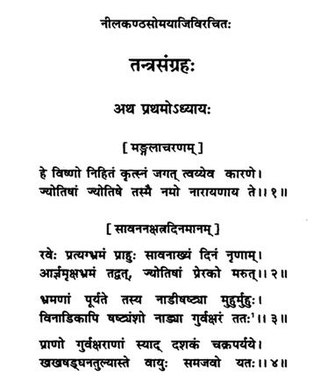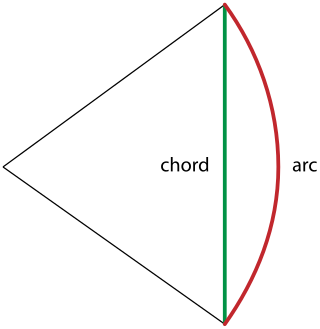
Flat Earth is an archaic and scientifically disproven conception of the Earth's shape as a plane or disk. Many ancient cultures subscribed to a flat-Earth cosmography. The model has undergone a recent resurgence as a conspiracy theory.

In trigonometry, the law of sines, sine law, sine formula, or sine rule is an equation relating the lengths of the sides of any triangle to the sines of its angles. According to the law,

Spherical geometry or spherics is the geometry of the two-dimensional surface of a sphere or the n-dimensional surface of higher dimensional spheres.

The versine or versed sine is a trigonometric function found in some of the earliest trigonometric tables. The versine of an angle is 1 minus its cosine.

The haversine formula determines the great-circle distance between two points on a sphere given their longitudes and latitudes. Important in navigation, it is a special case of a more general formula in spherical trigonometry, the law of haversines, that relates the sides and angles of spherical triangles.
The timeline below shows the date of publication of possible major scientific breakthroughs, theories and discoveries, along with the discoverer. This article discounts mere speculation as discovery, although imperfect reasoned arguments, arguments based on elegance/simplicity, and numerically/experimentally verified conjectures qualify. The timeline begins at the Bronze Age, as it is difficult to give even estimates for the timing of events prior to this, such as of the discovery of counting, natural numbers and arithmetic.

Abū ʿAbd Allāh Muḥammad ibn Jābir ibn Sinān al-Raqqī al-Ḥarrānī aṣ-Ṣābiʾ al-Battānī, usually called al-Battānī, a name that was in the past Latinized as Albategnius, was an astronomer, astrologer and mathematician, who lived and worked for most of his life at Raqqa, now in Syria. He is considered to be the greatest and most famous of the astronomers of the medieval Islamic world.
Abu Mahmud Hamid ibn al-Khidr al-Khujandi was a Muslim Transoxanian astronomer and mathematician born in Khujand who lived in the late 10th century and helped build an observatory, near the city of Ray, in Iran.

Ancient Greek astronomy is the astronomy written in the Greek language during classical antiquity. Greek astronomy is understood to include the Ancient Greek, Hellenistic, Greco-Roman, and late antique eras. It is not limited geographically to Greece or to ethnic Greeks, as the Greek language had become the language of scholarship throughout the Hellenistic world following the conquests of Alexander. This phase of Greek astronomy is also known as Hellenistic astronomy, while the pre-Hellenistic phase is known as Classical Greek astronomy. During the Hellenistic and Roman periods, many of the Greek and non-Greek astronomers working in the Greek tradition studied at the Museum and the Library of Alexandria in Ptolemaic Egypt.

Early study of triangles can be traced to the 2nd millennium BC, in Egyptian mathematics and Babylonian mathematics. Trigonometry was also prevalent in Kushite mathematics. Systematic study of trigonometric functions began in Hellenistic mathematics, reaching India as part of Hellenistic astronomy. In Indian astronomy, the study of trigonometric functions flourished in the Gupta period, especially due to Aryabhata, who discovered the sine function, cosine function, and versine function.

Tantrasamgraha, or Tantrasangraha, is an important astronomical treatise written by Nilakantha Somayaji, an astronomer/mathematician belonging to the Kerala school of astronomy and mathematics. The treatise was completed in 1501 CE. It consists of 432 verses in Sanskrit divided into eight chapters. Tantrasamgraha had spawned a few commentaries: Tantrasamgraha-vyakhya of anonymous authorship and Yuktibhāṣā authored by Jyeshtadeva in about 1550 CE. Tantrasangraha, together with its commentaries, bring forth the depths of the mathematical accomplishments the Kerala school of astronomy and mathematics, in particular the achievements of the remarkable mathematician of the school Sangamagrama Madhava. In his Tantrasangraha, Nilakantha revised Aryabhata's model for the planets Mercury and Venus. According to George G Joseph his equation of the centre for these planets remained the most accurate until the time of Johannes Kepler in the 17th century.

MathPath is a mathematics enrichment summer program for students ages 11–14. It is four weeks long, and moves to a different location each year. MathPath is visited by mathematicians such as John H. Conway and Francis Su. It was probably the original, and is still one of the few, international residential high-end summer camps exclusively for mathematics and exclusively for students of middle school age.

Trigonometry is a branch of mathematics concerned with relationships between angles and side lengths of triangles. In particular, the trigonometric functions relate the angles of a right triangle with ratios of its side lengths. The field emerged in the Hellenistic world during the 3rd century BC from applications of geometry to astronomical studies. The Greeks focused on the calculation of chords, while mathematicians in India created the earliest-known tables of values for trigonometric ratios such as sine.
Jyā, koṭi-jyā and utkrama-jyā are three trigonometric functions introduced by Indian mathematicians and astronomers. The earliest known Indian treatise containing references to these functions is Surya Siddhanta. These are functions of arcs of circles and not functions of angles. Jyā and koti-jyā are closely related to the modern trigonometric functions of sine and cosine. In fact, the origins of the modern terms of "sine" and "cosine" have been traced back to the Sanskrit words jyā and koti-jyā.

Āryabhata's sine table is a set of twenty-four numbers given in the astronomical treatise Āryabhatiya composed by the fifth century Indian mathematician and astronomer Āryabhata, for the computation of the half-chords of a certain set of arcs of a circle. The set of numbers appears in verse 12 in Chapter 1 Dasagitika of Aryabhatiya. It is not a table in the modern sense of a mathematical table; that is, it is not a set of numbers arranged into rows and columns. Āryabhaṭa's table is also not a set of values of the trigonometric sine function in a conventional sense; it is a table of the first differences of the values of trigonometric sines expressed in arcminutes, and because of this the table is also referred to as Āryabhaṭa's table of sine-differences.

Muhammad ibn Muhammad ibn al-Hasan al-Tusi, also known as Nasir al-Din al-Tusi or simply as (al-)Tusi, was a Persian polymath, architect, philosopher, physician, scientist, and theologian. Nasir al-Din al-Tusi was a well published author, writing on subjects of math, engineering, prose, and mysticism. Additionally, al-Tusi made several scientific advancements. In astronomy, al-Tusi created very accurate tables of planetary motion, an updated planetary model, and critiques of Ptolemaic astronomy. He also made strides in logic, mathematics but especially trigonometry, biology, and chemistry. Nasir al-Din al-Tusi left behind a great legacy as well. Tusi is widely regarded as one of the greatest scientists of medieval Islam, since he is often considered the creator of trigonometry as a mathematical discipline in its own right. The Muslim scholar Ibn Khaldun (1332–1406) considered Tusi to be the greatest of the later Persian scholars. There is also reason to believe that he may have influenced Copernican heliocentrism.
The Spherics is a three-volume treatise on spherical geometry written by the Hellenistic mathematician Theodosius of Bithynia in the 2nd or 1st century BC.

A Lénárt sphere is a educational manipulative and writing surface for exploring spherical geometry, invented by Hungarian István Lénárt as a modern replacement for a spherical blackboard. It can be used for visualizing the geometry of points, great and small circles, triangles, polygons, conics, and other objects on a sphere, and comparing spherical geometry to Euclidean geometry as drawn on a flat piece of paper or blackboard. The included spherical ruler and compass support synthetic straightedge and compass construction on the sphere.
Hans Boersma is a Dutch-Canadian Anglican theologian specialising in patristics, sacramental theology, and nouvelle théologie. He is of Reformed background, but has become a convert and a priest in the Anglican Church in North America.
In trigonometry, the sinus totus was historically the radius of the base circle used to construct a sine table; that is, the maximum possible value of the sine.












